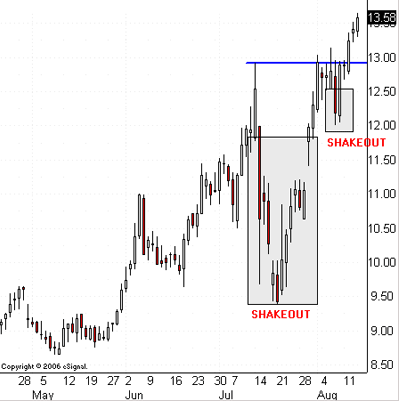

Trading may not be rocket science, but the path to success at it may seem just as complicated at times. Fortunately, you can do some things to cut down the considerable learning curve. Start by writing an effective trading plan. Then, use those rules and criteria to avoid the traps and pitfalls of a typical market day.
Once you draw up your plan, follow it for a few weeks, and then start an introspective journal that lists every trade and how it worked out. Make small adjustments as you go forward, and test each modification to your overall strategy. Don't rush. Save big changes for weekends and holidays when you have more time to examine their impact.
Compare the plan to the journal notes, and see how your daily activities characterize your individual trading style. Today's volatile markets demand constant attention, and the journal will keep you focused squarely on your long-term goals. However, never use it as an excuse to make bad decisions.
Here are 10 tips and techniques to help you build an effective trading plan.
1. Define your personal style. This approach includes your execution rules, stock choices, position size and the filters that tell you when it's time to stand aside.
2. Match your trading to the realities of your life. Choose a suitable holding period because everything else you do is defined by it. Base your decision on experience and available capital. Then, consider other lifestyle considerations, such as family and free time.
3. Review your goals for trading the markets. Is risk aversion or financial return more important to you? Do your profits need to pay the mortgage or just the next vacation? If you're not sure what your goals are, trade small until you figure them out.
4. Align position size with equity stake and risk tolerance. Never overtrade a small account in hopes of building it up. Apply the limited stake to longer-term positions rather than flipping them repeatedly. Decide when and how to use margin.
5. Define your entry and exit rules. Decide what your opportunity needs to look like before taking the trade. List out exactly what must happen in the minutes or hours before you pull the trigger.
6. Choose a price range you want to trade. Then, pick up the right number of shares for each position. Trade more shares when your ducks line up in a row, and reduce size when they don't. Limit shares to manage risk, and trade small when trying out new tactics or time frames.
7. Decide whether to use limit or market orders. Will you use physical or mental stops? A lot depends on whether or not you're sitting in front of your trading screen all day. If your lifestyle keeps you away from the markets, place physical stops on all positions.
8. Create rules to modify your trading plan moving forward. Fresh tactics require new risk considerations. Don't let your plan strangle new ideas, but add them slowly and make sure they're an improvement to the big picture.
9. Decide where to focus your efforts at the start of each market day. Your time is limited, and it's easy to get overwhelmed, so save your energy for the most urgent tasks.
10. Choose your information sources. Will you listen to the news or the numbers? Will you trade through economic releases or close out ahead of the news and step to the sidelines? Finally, decide whether the television stays on or off during market hours.
Now that you have a trading plan in place, you need to put it into action. Realistically, you can lose money in the financial markets many different ways. And, if you play this game long enough, you'll get to know most of them intimately. Fortunately, your plan empowers you to avoid many of the traps and pitfalls faced by other traders.
Above all else, learn to recognize market situations that place you at the most risk. The following scenarios cover a wide variety of these common dangers.
1. Placing Bad Stops

Incorrect stop placement will shake you out of good positions. Doing it correctly is simple to learn but takes a lifetime to apply with skill and accuracy. It's also the weakest link in most trading plans. Stops do best when they’re placed outside the market noise while also keeping risk to a minimum.
Many traders believe professionals hit their stops because they have inside knowledge about where they're being placed, but the truth is less mysterious. Most of us place stops in the same old places, so they become attractive targets for those who understand intraday market movement.
2. Trading Choppy Markets
A good pattern won't bail you out of a choppy market. Move to the sidelines when conflict and indecision take charge of the price action. Keep in mind that equities follow the major indices most of the time, regardless of individual trends. This overriding force can induce the most perfect pattern to fail badly.
Long-term survival depends on effective trade management. Most of the time, technical analysis does a great job outlining reward / risk and uncovering hidden dangers. But, choppy price swings can take control of the market at any time. A good rule is this: Don’t trade when you can't measure your risk, and stand aside when you can't find your edge.
3. Trading at the Wrong Time
It's easy to be right but still lose money. We spend hours searching for the great trade but forget that entry and exit timing is just as important. Stocks are forced to negotiate a minefield of conflicting trends, each dependent on different time frames. Your positions need to align with these cycles to capture the profits you visualized in your trade analysis.
But, don't drive yourself crazy because there's a limit to your study time. You can spend hours looking for perfect alignment between time frames but then freeze when it's time to make a trade decision. Realistically, the markets are drawn in shades of gray, and not all your ducks will line up in a row before you need to take action.
4. Getting on the Wrong Boat
Market wisdom tells us that rising seas will float all boats in a bull market. Most of the time, big rallies begin with strong stocks in strong sectors and then broaden into lagging groups. Finally, the bottom of the barrel wakes up and joins the party. It's this last group that gets traders into the most trouble, so choose your exposure wisely.
In addition, some stocks never rally, even in the best of times. Look for basing patterns, tests at support and real buyers before you risk capital on a questionable stock. Then, get out at the first sign of danger because market laggards have real weights tied to their legs and will be the first ones to roll over when the ticker tape turns south.
5. Getting Shaken Out

Modern markets seem to burn everyone before they launch definable trends. Through volatility, mechanics or just plain chaos, price action can rip through support and resistance with relative ease. These whipsaws can shake out perfectly good positions before a market moves higher or lower.
Why do these shakeouts occur? The majority of traders enter positions using strategies that have already been deconstructed by market professionals. In a sense, the common buying and selling signals found in books are turned against the naive folks using them. Of course, much of the damage can be avoided with an effective trading plan